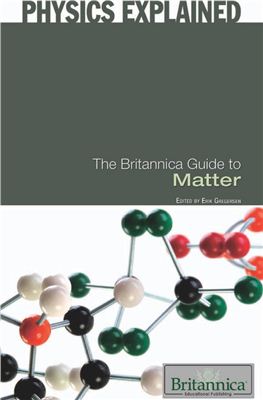Rosen Educational Services, Britannica Educational Publishing,
2011, 274 pages
The ordinary experience of matter encompasses three different types or phases: solid, liquid, and gas. These phases follow how a substance holds itself together. Solids remain, for lack of a better word, solid. Liquids do not hold themselves together. Gases are made of atoms or molecules. Aside from collisions, there is no relation between one atom or molecule and another atom or molecule.
Solids are classified on the basis of the order of their inteal structure, with the most ordered of all being the crystalline solids.
Aside from the three forms of gas, liquid, and solid are intermediate forms that partake of the properties of two different phases. One of these forms is the liquid crystal, which has some of the properties of a liquid and some of a crystalline solid. The amorphous solid is held together by the same chemical bonds that bind the crystalline solids. Another intermediate form is that of the quasicrystals, so called because they have some of the regular patte behaviour of crystals but also the irregularity of the amorphous solids.
Beyond solid, liquid, and gas there is plasma, which has been called the fourth state of matter. Plasmas are gas in which the atoms are ionized such that there are as many atoms that are negatively charged as positively charged.
Clusters are another form of matter, made up of groups of atoms and molecules that form in solids and liquids.
Matter and Its Phases
Properties of Gases
Kinetic Theory of Gases
Properties of Liquids
Liquid Solutions and Solubility
Crystalline Solids and Liquid Crystals
Amorphous Solids and Quasicrystals
Plasma
Clusters
The ordinary experience of matter encompasses three different types or phases: solid, liquid, and gas. These phases follow how a substance holds itself together. Solids remain, for lack of a better word, solid. Liquids do not hold themselves together. Gases are made of atoms or molecules. Aside from collisions, there is no relation between one atom or molecule and another atom or molecule.
Solids are classified on the basis of the order of their inteal structure, with the most ordered of all being the crystalline solids.
Aside from the three forms of gas, liquid, and solid are intermediate forms that partake of the properties of two different phases. One of these forms is the liquid crystal, which has some of the properties of a liquid and some of a crystalline solid. The amorphous solid is held together by the same chemical bonds that bind the crystalline solids. Another intermediate form is that of the quasicrystals, so called because they have some of the regular patte behaviour of crystals but also the irregularity of the amorphous solids.
Beyond solid, liquid, and gas there is plasma, which has been called the fourth state of matter. Plasmas are gas in which the atoms are ionized such that there are as many atoms that are negatively charged as positively charged.
Clusters are another form of matter, made up of groups of atoms and molecules that form in solids and liquids.
Matter and Its Phases
Properties of Gases
Kinetic Theory of Gases
Properties of Liquids
Liquid Solutions and Solubility
Crystalline Solids and Liquid Crystals
Amorphous Solids and Quasicrystals
Plasma
Clusters

